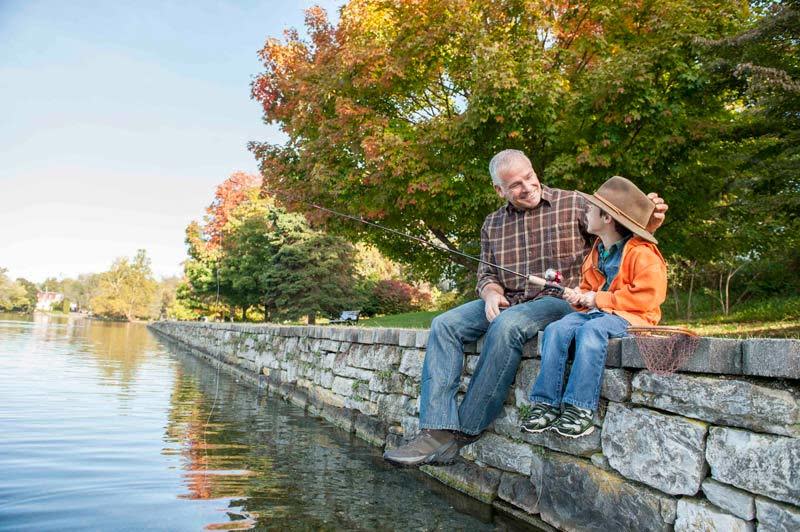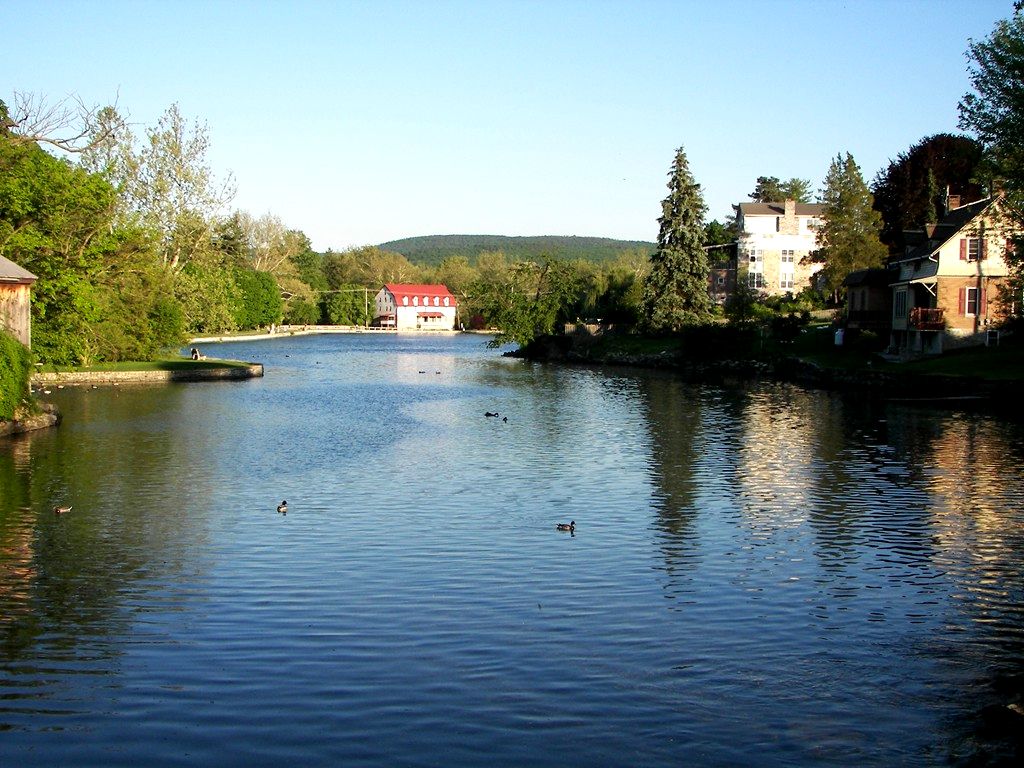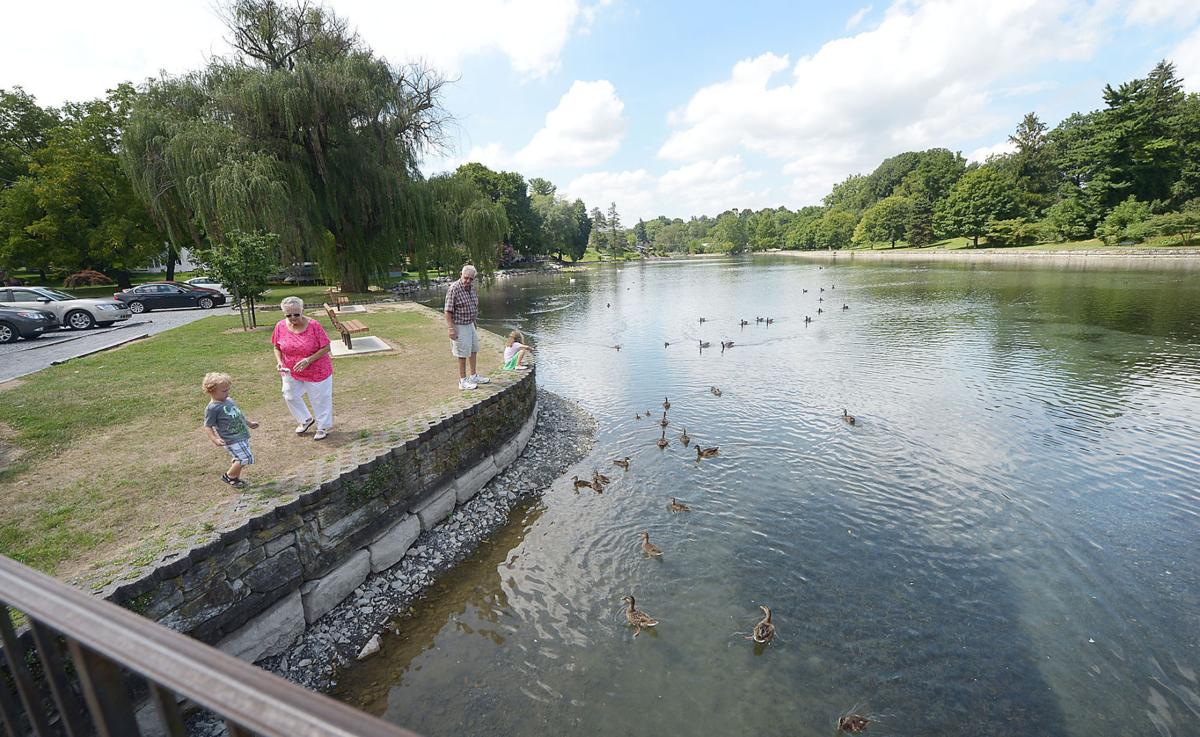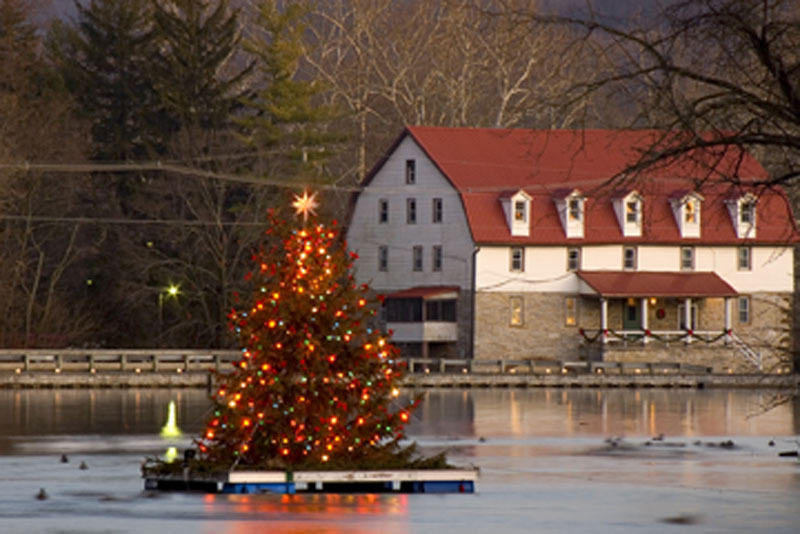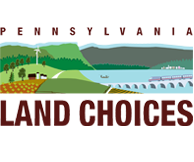Children’s Lake
Location: Boiling Springs (Cumberland County)
Organization: Appalachian Trail Conservancy
The community of Boiling Springs did not want to lose the lake and its picturesque surroundings. It was where the village tree was lit during the winter holidays and the setting for Independence Day boat races and other summer fun. The lake was part of Boiling Spring’s identity. Although privately owned, it had always been open to the public to some degree.
Many who lived in the village never gave a thought to the lake being closed off—until it went on the market.
Do you come down here a lot?”
“Every day, if my mom lets me,” the young boy, perhaps eight, whispered, conscious of the grown-ups behind him, on the other side of the tree. A lakeside news conference was in progress, having brought four television crews to the centerpiece of his small Cumberland Valley hometown, near the center point of the Appalachian Trail.
“Do you like all the ducks?”
“Yeah!”
“Catch any fish?”
“Once, but it was little, and I let him go.”
“I’ve caught three,” his buddy chimed in.
Moments later, Paul Bucher, representing the heirs of the estate of J.C. Bucher, told the reporters and about sixty of his village neighbors that his family was “very pleased” by the agreement it had signed to sell historic Boiling Springs Lake and part of the surrounding property to the Appalachian Trail Conference Land Trust (ATC) after more than four years of negotiations.
“Now we know it will always be here for the children,” Bucher said.
A Community Threatened
After their father died, the Bucher brothers put their newly inherited property up for sale. The fifty-acre tract included Boiling Springs Lake, its shorefronts and historic structures.
The community of Boiling Springs did not want to lose the lake and its picturesque surroundings. It was where the village tree was lit during the winter holidays and the setting for Independence Day boat races and other summer fun. The lake was part of Boiling Spring’s identity. Although privately owned, it had always been open to the public to some degree. Many who lived in the village never gave a thought to the lake being closed off — until it went on the market. Local residents began organizing and formed Citizens United for Preservation.
Appalachian Trail Conservancy
While the Boiling Springs residents were starting to deal with the threat to their community, the Appalachian Trail Conservancy was trying to deal with its own problem. Decades before, when the Appalachian Trail had first been pieced together through Cumberland County, the trail had been routed along lands and roads in an isolated rural area. Now, increasing development and road traffic in the Cumberland Valley made it necessary to relocate a 16-mile section of trail.
ATC had been looking at a potential new route in the vicinity of Boiling Springs. ATC saw in the Bucher property an opportunity to both help the local community and Appalachian Trail users. The Bucher property could provide part of the route — an idyllic route — for the trail relocation.
Led by a local ATC volunteer, Craig Dunn, the ATC initiated negotiations with the Bucher family to purchase their property on behalf of the residents and various organizations interested in protecting the property’s many conservation values. Four years later, the deal was made. ATC bought the property and then transferred portions of it to appropriate government agencies. The National Park Service received the trail land, which extends 30 feet back from the lakeshore. A short bluff overlooking that strip — a footpath known locally as Lovers Walk — was protected through development restrictions. The lake itself was transferred to the Pennsylvania Fish & Boat Commission.
Individuals and organizations in the area made donations to the Trust to underwrite the purchase. Local industrialist, Frank Masland, led the charge, donating roughly half of the purchase price. At Mr. Masland’s request, the lake was renamed Children’s Lake.
A History with the Community
Boiling Springs was part of a tract conveyed in 1762 by the Commonwealth’s founding Penn family to several settlers, who often had to flee to Carlisle during Indian attacks. The settlers contained the springs, which you can now see bubbling above the lake’s surface from caves an estimated 1,800 feet below ground.
A water-powered gristmill, the miller’s home, and a blacksmith shop were the first lakeside buildings. In 1872, owner Carey W. Ahl built the stonewall around the lake and planted trees along the shoreline. In the Roaring Twenties, the site hosted a 1,000-square-foot dance hall, serviced by a trolley line from Carlisle.
Today, the lake and its surroundings are a public asset, providing picnicking, fishing, walking and other recreation to residents and visitors. Historic structures, including the gristmill, decorate the shores. The sounds of ducks, geese, and children at play fill the air.
Thanks to the Appalachian Trail Conference Land Trust, the lake will always be accessible to ducks, geese and the children who thrill in their antics.
Family Values
Playing at the water’s edge, five-year old Emma Engle and her brother, Owen, 2, are oblivious to the history of Children’s Lake.
They just like to “dip.”
Every morning, rain or shine, they walk from their village home to Children’s Lake and the dipping begins.
“She’s just got to get those toes in the water,” laughed her mother, Elaine Engle. “We come here everyday. It has to be really bad outside for us to miss it.”
Other moms with children wave and greet the family, and for a few minutes, the world is run by 2-year-olds and the noisy waterfowl calling to them.
This scene is the life Elaine always pictured when she thought about having children.
The first time she saw the lake, a vision of raising children in the village was emblazoned in her mind. She saw herself walking the shores with her children, met by a cadre of ducks, geese and swans welcoming her children’s gifts of stale hot-dog rolls.
“When we first stood by the lake, I said to my husband, ‘We have to move here,'” Elaine said. “We knew the community was good and the schools were good too, but we really bought our house for the lake. The kids think of it as their second back yard.”
The lake is central to the lives of many Boiling Springs residents. It’s the village square, albeit a watery one. A recent entry in the Appalachian Trail logbook by a hiker reads:
“I pulled into Boiling Springs today and found the whole town fishing in the lake. What a great town.”
Long-distance hikers will stop in the village to stock up on supplies, mail a letter home and maybe spend a night in a comfy bed. Lunching at the historic Tavern at Boiling Springs or strolling streets lined with beautifully kept 19th century homes provide a pleasant change of pace.
“The hikers that come through are amazed by the village,” Nancy Tritt, a long-time resident and receptionist at the ATC office on the lake. “They say the village is something from long ago. There aren’t too many like Boiling Springs left.”
The Appalachian Trail
A hiker finishing the entire length of the Appalachian Trail will have trekked 2,172 miles from Maine to Georgia. Pennsylvania claims 239 miles of the trail. The Appalachian Trail is the longest skinniest National Park. While administered by the National Park Service, 31 local trail clubs in 14 states maintain it. The Appalachian Trail Conference is a confederation of these trail clubs.
The National Park Service only needs to acquire ten or so miles of corridor to complete protection of the entire trail route. Of that, two miles are in Pennsylvania.
“Now that protection of the footpath is nearly complete, the land trust can focus more on preserving the scenic outlooks, historical and natural features that enhance the trail experience,” said Robert B. Williams, director of the ATC Land Trust.
“We seek and hold easements on countryside that is determined to be significant to the trail experience. That could be property with a view shed or another reason, whether that be bear habitat or important to protect water resources,” Williams said.
“Thirty years from now, will Appalachian Trail users still be able to enjoy a footpath that winds through forests and farms, a diversity of plants and animals, and the solitude of a natural setting? Or will their trail be just another generic strip of a few hardy species of trees, shrubs, and grasses on either side of a suburban path? There’s a lot of work that can still be done in Pennsylvania.”
